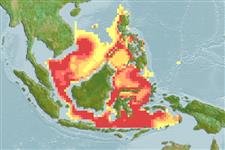Teleostei (teleosts) >
Myctophiformes (Lanternfishes) >
Myctophidae (Lanternfishes) > Diaphinae
Etymology: Diaphus: Greek, dis, dia = through + Greek, physa, phyo = to beget, to have as offspring (Ref. 45335).
Eponymy: Edward Macfarlane Ehrhorn (1862–1941) was an entomologist and horticulturist. [...] (Ref. 128868), visit book page.
More on author: Fowler.
Environment: milieu / climate zone / depth range / distribution range
Ecology
Marine; bathypelagic; depth range ? - 382 m (Ref. 280). Deep-water
Distribution
Countries | FAO areas | Ecosystems | Occurrences | Point map | Introductions | Faunafri
Western Central Pacific: Philippines.
Size / Weight / Age
Maturity: Lm ? range ? - ? cm
Life cycle and mating behavior
Maturity | Reproduction | Spawning | Eggs | Fecundity | Larvae
Paxton, J.R., 1979. Nominal genera and species of lanternfishes (Family Myctophidae). Contrib. Sci. Natur. Hist. Mus. Los Angeles County, 322:1-28. (Ref. 5572)
IUCN Red List Status (Ref. 130435: Version 2024-2)
Threat to humans
Harmless
Human uses
Tools
Special reports
Download XML
Internet sources
Estimates based on models
Preferred temperature (Ref.
123201): 16.5 - 27.7, mean 23.8 °C (based on 70 cells).
Phylogenetic diversity index (Ref.
82804): PD
50 = 0.5000 [Uniqueness, from 0.5 = low to 2.0 = high].
Bayesian length-weight: a=0.01122 (0.00358 - 0.03515), b=2.99 (2.74 - 3.24), in cm total length, based on LWR estimates for this (Sub)family-body shape (Ref.
93245).
Trophic level (Ref.
69278): 3.1 ±0.3 se; based on size and trophs of closest relatives
Resilience (Ref.
120179): High, minimum population doubling time less than 15 months (Preliminary K or Fecundity.).
Fishing Vulnerability (Ref.
59153): Low vulnerability (10 of 100).
